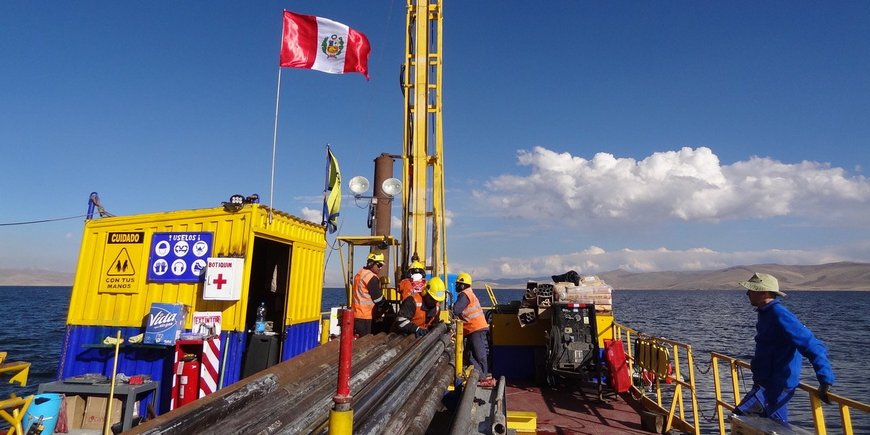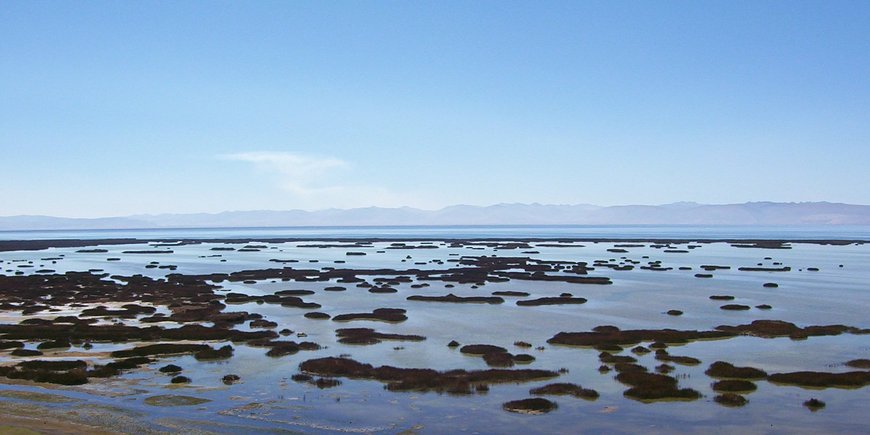The scope and the potential impacts of the advancing climate change are amongst the globally most significant challenges of mankind. In order to understand the mechanisms of climate change or even to predict its future development, it is necessary to know the circumstances during past changes in Earth's climate history.
The effects of past climate changes can be seen particularly well in lake sediments. Hence, the collection of a continuous drill core sequence from lacustrine sediments is one way to gain paleoclimatic records.
In 2015, the International Continental Scientific Drilling Program (ICDP) supported a scientific drilling campaign to obtain and study high-resolution paleoclimate records from lacustrine sediments in order to reconstruct the history of the continental glacial-interglacial cycles of Lake Junín in Peru. A recently published paper in Nature now reports on selected data from Lake Junín Drilling Project in a multi-author study. The study was led by Prof. Donald T. Rodbell from Union College, USA and with the participation of GFZ scientists. The works identify that tropical glaciers followed the beat of the Northern Hemisphere ice sheets for the past 700,000 years, thus highlighting persistent, multiscaled, and fast-acting climate connections between the high and low latitudes.
Study area
The study area Lake Junín (Peru, 11.03°S, 76.11°W) is a large 300 km2 semi-enclosed basin located at 4085 m above sea level in the tropical Andes of Peru. Lake Junín is a prime target for drilling because it contains a thick (>125 m) sediment package deposited at a high rate (0.2 to 1.0 mm yr-1). It is one of the few lakes in the tropical Andes that predate the maximum extent of glaciation and is located in a geomorphic position that allows to record the waxing and waning of glaciers in the nearby Cordillera. This makes the lake a key site for investigating Quaternary climate evolution of the inner-tropics of the Southern Hemisphere.
The study now details the first independently-dated and continuous archive of tropical glaciation spanning numerous glacial-interglacial cycles. Already published records from regional cave speleothems have been incorporated into the recent data set to improve the interpretation, thus supporting the regional significance of the now published interpretations. It is a groundbreaking record of tropical glaciation and interhemispheric climate linkages.
Results
The authors illustrate the sensitivity of the tropical Andes and adjacent Amazon Basin to climatic changes in a distant high latitude region. Their results are relevant in the light of recent observations of (i) accelerated arctic warming which is more pronounced in the last three decades, resulting rapid sea ice loss, (ii) changes in Atlantic deep-water formation due to the higher temperature gradient causing reduced precipitation and increased evaporation in the tropical Andes, and (iii) ongoing deforestation and drought in the Amazon will make the area warmer and drier resulting in reduced rainfall and drying of groundwater.
GFZ scientists did measurements inside the borehole
The reconstruction of an uninterrupted climate record like presented in this paper relies on the completeness of the core sequence. It is paramount to proof that the drill core record is complete and does not have any gaps.
The GFZ science team has conducted several measurements inside the borehole, so-called downhole logging, but not on drill core. Gaps in the sequence can be identified by comparison of the magnetic susceptibility measured on the core pieces with the continuous curve measured downhole, a process called depth matching. When gaps were identified, an additional hole was drilled at the same site only a few meters away in order to fill the core gap of the first hole.
In addition, the GFZ borehole measurements provided further continuous, in-situ measured and very depth reliable data of various physical, chemical and structural parameters of the drilled sediments. Results from the analysis of these data will be published soon.
Original publication:
Rodbell, D.T., Hatfield, R.G., Abbott, M.B., Chen, C.Y., Woods, A., Stoner, J.S., McGee, D., Tapia, P.M., Bush, M., Valero-Garcés, B.L., Mark, S. Z., Weidhaas, N.C., Hillman, L., Larsen, D. J., Delgado, G., Katz, S. A., Solada, K. E., Morey, A.E., Finkenbinder, M., Valencia, B., Rozas-Davila, A., Wattrus, N., Colman, S.M., Bustamante, M.G., Kück, J., Pierdominici, S.:700,000 years of Tropical Andean Glaciation. Nature (2022), https://doi.org/10.1038/s41586-022-04873-0












![[Translate to English:] Torsten Sachs in front of a climate station on a field](/fileadmin/_processed_/3/9/csm__TorstenSachs_bearbeitet_GS_4a1365ef84.jpeg)

![[Translate to English:] left image flood at the Ahrtal: image from above, several houses are flooded; left image:: Heidi Kreibich;](/fileadmin/_processed_/4/4/csm_Bild2_9af0130e9f.png)



![[Translate to English:] Start der Vega Rakete](/fileadmin/_processed_/6/4/csm_20231201-kachel_Vega-VV23-launch_ESA-CNES-Arianespace_706716b68c.jpeg)









![[Translate to English:] Poster exhibition at the Brandenburg Hydrogen Day at the GFZ, some participants in the foreground](/fileadmin/_processed_/6/5/csm_Erster_Brandenburgischer_Wasserstofftag_GFZ_402fcec95e.jpeg)
![[Translate to English:] Group picture of the participants](/fileadmin/_processed_/9/4/csm_20231108_CAWa-Workshop-Tashkent_Gruppenbild_99ea779d8a.jpeg)

![[Translate to English:] [Translate to English:] Hörsaal](/fileadmin/_processed_/e/6/csm_H%C3%B6rsal_e21ac645fb.jpeg)


![[Translate to English:] The Delegations in the Historic Library on the Telegrafenberg. In the back there are from left to right, the Dutch Ambassador for Germany, Ronald van Roeden, the Dutch Minister for Education, Culture and Science, Robbert Dijkgraaf and the scientific director of the GFZ, Susanne Buiter.](/fileadmin/_processed_/d/b/csm_Kachel-2_9eba4b4212.jpeg)

